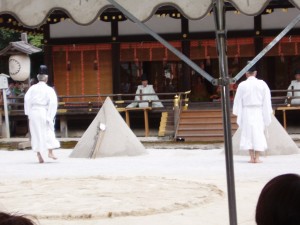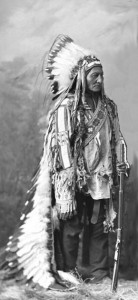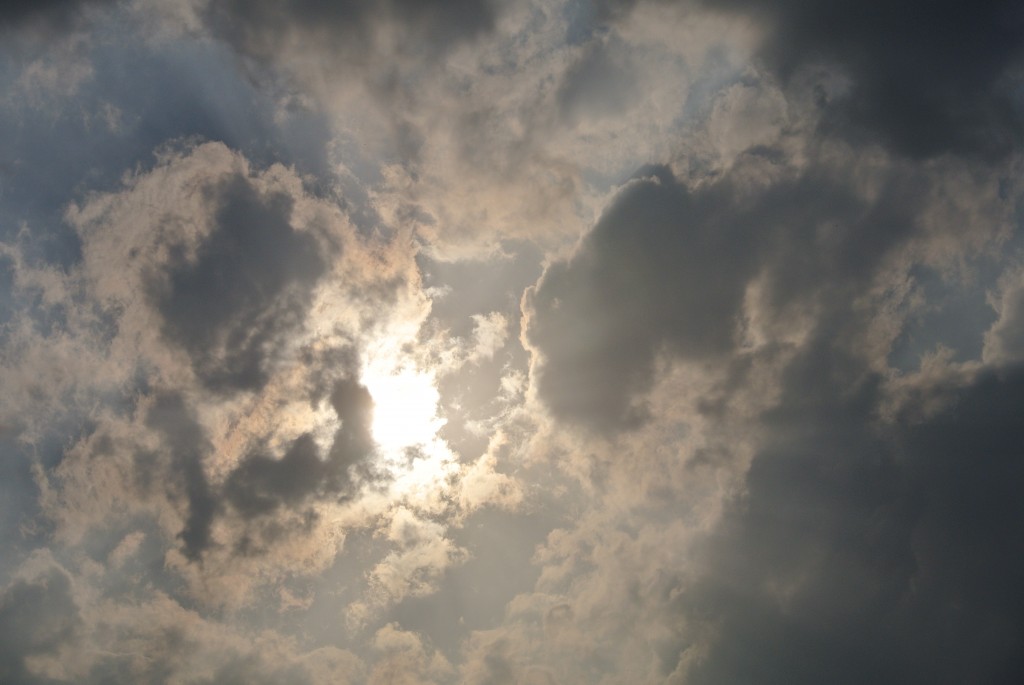The thunder kami
It takes place on May 12. It’s held in secret. And it’s one of Japan’s oldest continuous rites. It’s the little known, and mysterious, Miare sai held by Kamigamo Shrine in Kyoto.

Priests at Kamigamo Jinja engaged in another ancient shamanistic rite: the Crow Festival every September
The rite is carried out in the dark by the priests of Kamigamo Jinja at the south-western base of their sacred mountain, Koyama. it’s where their kami, the thunder-god Kamo no Wake-ikazuchi, descended in prehistoric times. One theory holds that he descended in the form of lightning, which would make sense for a thunder deity!
The kami was born in remarkable manner to a shamaness known as Tamayori no hime (Spirit Summoning Princess). While sitting by the river one day, she came across a red arrow floating downstream and took it home. Miraculously, she became pregnant.
The young boy she gave birth to turned into a prodigy, and when he was just three years old, his grandfather asked him at a gathering to point out his father. ‘I am the son of a Heavenly Deity,’ he replied, wherewith he ascended to the heavens. The Kamo clan, of whom the grandfather was leader, adopted the young boy’s spirit as their kami.
Ritual observance
The form of the rite was dictated by the kami himself, for Wake-ikazuchi appeared to his grandfather in a dream and gave him instruction about how he wished to be worshipped.
‘If you wish to see me, make some heavenly feather robes, light fires, set up spears, decorate running horses and with stout wood from the mountains set up ‘are‘ poles and from them hang down many coloured ornaments, make wigs of Aoi and Katsura and solemnly decorate yourself with them and wait for me to come.’

Feathers play a part in many shaman costumes
A heavenly feather robe, decorations, the drawing down of the spirit into ornamented poles – there’s much of shamanism here. The present-day ceremony retains some of the original flavour by taking place with just a handful of people in the dark. ‘Mukae tamae mukae tamae,’ they chant (Come we beseech you).
During the rite the kami is invited to descend into yorishiro (vessel for the kami), consisting of five sakaki branches festooned with hei (strips of paper). It’s thought there may have once been five priests who each held a branch to receive the spirit. Afterwards the yorishiro are taken to the shrine so that the kami can be installed there.
Getting into the spirit of Aoi Festival
The idea of the ceremony is that the kami will arrive just before Aoi Matsuri, which is held three days later. The name of the rite, Miare, can mean birth, resurrection, or renewal – apt enough for a festival that occurs in spring and celebrates the rebirth of the life-force and the overcoming of disease.
What’s interesting is that both the Miare rite of Kamigamo Shrine and the Mikage Festival of its sister shrine, Shimogamo, take place on May 12th. One’s in the daytime and in public. The other is in the dark, in the woods, and in secret. Yet both events can be seen as important preparations for the Aoi Festival, bringing down their respective kami from a sacred mountain.
When the big day comes, on May 15, the kami will be ready for the entertainment and offerings. There’ll be 500 people in full processional gear, and a messenger from the emperor himself. If the kami is pleased, it bodes well for the rest of the year and for avoiding the dreaded plague that once ravaged the community.
Here then is the message I derive from the rite. From mountains we derive the vitality to sustain us against disease and negativity. In climbing to the top of the hill, we grow closer to heaven and in so doing enhance our spiritual and physical well-being.

The celestial home of Kamo Wake-ikazuchi
*******************************************************************
Information is taken from John Nelson’s Enduring Identities and Gunther Nitschke’s From Shinto to Ando.

Leave a Reply